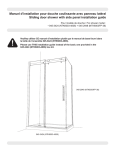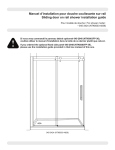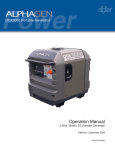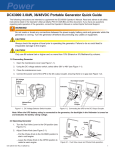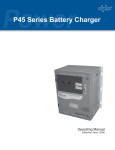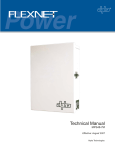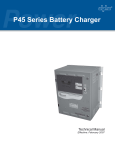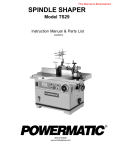Download Wilton 17204 Specifications
Transcript
6" Bench Grinder Model No. 17204 6" BENC H GRIN Operation and Safety Instructions For your safety WARNING: Read and understand all instructions. Failure to follow all instructions may result in electric shock, fire and/or serious injury. DER IMPORTANT INFORMATION INTRODUCTION SPECIFICATIONS Your 6" Bench Grinder is a dependable tool that is designed for hand-grinding operations such as sharpening chisels, screwdrivers, drill bits, removing excess metal, and smoothing metal surfaces. Easy to operate, it’s the ideal bench grinder for the serious Do-It-Yourselfer. Model Number ................................................. 17204 Power Source.....................................120V AC, 60 Hz Maximum developed horsepower .....................1/2 Hp Amps .......................................................................2.8 Speed ..........................................3450 RPM (no load) Wheel size ....................................6" x 3/4", 1/2" arbor Wire brush ...............................6" dia, 1/2" - 5/8" arbor Lamp.............................Automotive type 12 V, 6 Watt, single contact bayonet Tool rests ................................................Right and left Eye shields .............................................Right and left Spark arrestors .......................................Right and left Net weight ........................................24.1 lbs (10.9 kg) Please take time to read this Instruction Manual thoroughly. Pay attention to all safety rules. A thorough understanding of your bench grinder will enable you to use it to its full potential. LIMITED WARRANTY Wilton Power Tools are warranted against defects in workmanship and material for a period of two (2) years from the date of purchase. This warranty does not cover defects due directly or indirectly to misuse, abuse, negligence or accidents, normal wear-and-tear, improper repair or alterations, lack of maintenance, or use for purposes other than those for which the tool was designed. This warranty does not cover products used for commercial, industrial or educational purposes. Any return must be preauthorized, so please contact our Consumer Relations Department with warranty claims at 1-800-274-6848 for further instructions. If it is determined that the product is within this warranty, replacement parts or complete product replacement will be made at our discretion. WMH TOOL GROUPTM LIMITS ALL IMPLIED WARRANTIES TO THE PERIOD OF THE LIMITED WARRANTY FOR EACH PRODUCT. EXCEPT AS STATED HEREIN, ANY IMPLIED WARRANTIES OF MERCHANTABILITY AND FITNESS ARE EXCLUDED. SOME STATES DO NOT ALLOW LIMITATIONS ON HOW LONG THE IMPLIED WARRANTY LASTS, SO THE ABOVE LIMITATION MAY NOT APPLY TO YOU. WMH TOOL GROUPTM SHALL IN NO EVENT BE LIABLE FOR DEATH, INJURIES TO PERSONS OR PROPERTY, OR FOR INCIDENTAL, CONTINGENT, SPECIAL, OR CONSEQUENTIAL DAMAGES ARISING FROM THE USE OF OUR PRODUCTS. SOME STATES DO NOT ALLOW THE EXCLUSION OR LIMITATIONS OF INCIDENTAL OR CONSEQUENTIAL DAMAGES, SO THE ABOVE LIMITATION OR EXCLUSION MAY NOT APPLY TO YOU. TABLE OF CONTENTS IMPORTANT INFORMATION ....................................2 Introduction ..........................................................2 Specifications.......................................................2 LIMITED WARRANTY ...............................................2 SAFETY .....................................................................3 General Safety Warnings.....................................3 Special Safety Rules for Bench Grinders ............4 Electrical Requirements.......................................5 BEFORE YOU START...............................................7 Glossary of Terms................................................7 Unpacking Your Bench Grinder ...........................8 Assembly Instructions..........................................9 OPERATION ............................................................10 Light ...................................................................10 Mounting the Grinder .........................................10 Changing the Grinding Wheel ...........................10 Changing the Light Bulb ....................................11 Before Grinding..................................................11 When Grinding ...................................................11 Reshaping Grinding Wheel ................................11 Using Dressing Wheel .......................................12 MAINTENANCE.......................................................12 Lubrication .........................................................12 Cleaning.............................................................12 TROUBLESHOOTING.............................................13 SERVICE..................................................................14 2 SAFETY Wear the Proper Apparel – and nonslip footwear when operating power tools. Do not wear loose clothing, gloves, neckties, rings, bracelets or other jewelry which may become caught in moving parts. Keep long hair away from your face and tied back. Roll long sleeves above the elbow. Read, understand and follow all operating instructions, safety operations and symbols in this manual before operating and maintaining your power tool. WARNING: Indicates the presence of a hazardous situation which CAN cause SEVERE personal injury. Use Safety Goggles at all Times – which comply with ANSI Z87.1. Normal safety glasses only have impact resistant lenses and are not designed for safety. Wear a face or dust mask when working in a dusty environment. Use ear protection, such as plugs or muffs, during extended periods of operation. CAUTION: Indicates the presence of a hazardous situation which WILL or CAN cause MINOR or MODERATE PERSONAL injury, or could cause machine damage. Note: Indicates installation, operation or maintenance information which is important but not hazard-related. GENERAL SAFETY WARNINGS WARNING: Failure to read all instructions and follow the general safety warnings and other safety warnings and cautions may result in serious personal injury. Wear a Face Mask or Dust Mask – when the grinding operation produces dust. Secure Your Work – using clamps or a vise when practical. It frees both hands and is safer to operate the tool. Know Your Power Tool – read the instruction manual. Understand your power tool’s application, limitations and potential hazards. Don’t Overreach – and keep proper balance and footing at all times. Ground All Tools – this tool is equipped with a 3-prong plug, it must be plugged into a 3-contact electric outlet. The 3rd prong is a ground to provide protection against accidental electric shock. Never remove the 3rd prong on a grounded plug. Maintain Your Tools with Care – keeping them clean for best and safest performance. Disconnect Your Tool – by unplugging the power cord from the electrical outlet when making adjustments, changing parts, cleaning, or working on the tool. Keep Safety Guards in Place – and working order with proper adjustment and alignment. Keep Work Area Clean – to help prevent accidents. Take time to clean the tool, work area and especially the floor. The floor can become slippery from sawdust, wax and other materials. Avoid Accidental Starting – by ensuring the switch is in the OFF position and the power cord is unplugged from the electrical outlet. Use the Recommended Accessories – by the tool’s manufacturer. Refer to this instruction manual for approved accessories. Read, understand and follow the instructions supplied with accessories. Using incorrect accessories may be hazardous. Avoid Dangerous Environments – by not using power tools in damp, wet or raining environments. Provide an adequate work area that is properly illuminated. Keep Children Away – from the work area. Children and others should be a safe distance from the work area. Never Stand on the Tool – or store materials above or near it. Standing on the tool to reach materials could result in serious injury if it tips or is accidentally contacted. Make the Workshop Childproof – by using padlocks, master switches and removing starter keys from power tools. Check any Damaged Parts – and discontinue using a damaged tool until the part is carefully checked. Ensure that all parts will operate and perform properly. Check for alignment of moving parts, binding of moving parts, breakage of parts, mounting and any other conditions that may affect its operation. A guard or other part that is damaged should be properly repaired or replaced before using the tool. Don’t Force the Tool – beyond its designed rate. For a better and safer job, allow the tool to work within manufacturer’s recommendation. Use the Right Tool – for the job. Do not force a tool or its attachments to perform a task that it’s not designed to do. SAVE THESE SAFETY INSTRUCTIONS 3 SAFETY Never Leave the Tool Unattended While it’s Running – turn OFF the power. Do not leave the tool unattended until it reaches a complete stop. Only wear safety goggles that comply with ANSI Z87.1 The operation of any grinder can result in foreign objects being thrown into your eyes, which can result in severe eye damage. ● Glasses or goggles that are not in compliance with ANSI Z87.1 could break resulting in severe eye injury. Wear a face or dust mask when working in a dusty environment. ● Use ear protection, plugs or muffs, during extended periods of operation. Always use tool guards and eye shields provided with the grinder, safety goggles or other eye protection. Keep your thumbs and fingers away from the wheel. ● Drugs, Alcohol, Medication – are not to be used when operating the tool. Some dust created by power sanding, sawing, grinding, drilling, and other construction activities contain chemicals known to cause cancer, birth defects or other reproductive harm. Some examples of these chemicals are: – Lead from lead-based paints, – Crystalline silica from bricks, cement, and other masonry products, and – Arsenic and chromium from chemically treated lumber. To reduce your exposure to these chemicals: work in a well-ventilated area, use approved safety equipment, and use dust masks that are specially designed to filter out microscopic particles. Replace a cracked grinding wheel immediately. A cracked wheel can throw pieces at a high velocity. Handle wheels carefully; before replacing a wheel, check it for cracks. Tighten the spindle nut just enough to hold the wheel firmly: if the nut is tightened too much, the clamping strain can damage the wheel. Use only wheel flanges provided with grinder. When selecting a replacement wheel, be sure that the grinder will not exceed the manufacturer's recommended speed (RPMs) for the wheel. SPECIAL SAFETY RULES FOR BENCH GRINDERS WARNING: Do not operate your bench grinder until it is assembled, and you have read and understand the following instructions and the warning labels on the bench grinder. Before Operating Your Bench Grinder Check for proper assembly and proper alignment of moving parts. The diameter of the grinding wheel decreases with use. Adjust tool rests to maintain a distance of 1/16" or less from the wheel. Also keep the distance between the spark arrestor and grinding wheel 1/8" or less. Understand the function and proper use of: ● ● Eye shields Tool rests Do not stand in front of the grinder when starting it. There is always a possibility that a piece from a damaged grinding wheel may be thrown off when coming to full speed. To start the grinder, stand to one side and turn it on. Wait at side until the grinder comes up to full speed. Read, understand and follow all operating instructions and safety warnings in this manual. Read and understand warning labels on the bench grinder. Know the condition of your bench grinder. If any part is missing, bent or does not operate properly, replace the component before you continue to use your bench grinder. The exhaust chute will channel out sparks and debris. Be sure the exhaust is not in the vicinity of flammable material. Frequently clean grinding dust from the back of the grinder. Determine the type of work you are going to be doing before you operate your bench grinder. Properly protect your body including your eyes, hands, face and ears. Never force work against a grinding wheel. If the wheel is cold. Apply the work gradually to give the wheel an opportunity to warm. This will minimize the chance of wheel breakage. SAVE THESE SAFETY INSTRUCTIONS 4 SAFETY Keep all wheel guards in place. Do not use the grinder with the wheel guard removed. Use a separate electrical circuit for your tools. This circuit must not be less than a #12 wire and should be protected with a 15 Amp time delayed fuse. Before connecting the motor to the power line, make sure the switch is in the OFF position and the electric current is rated the same as the current stamped on the motor nameplate. Running at a lower voltage will damage the motor. Do not try to cut anything with the grinding wheel. ELECTRICAL REQUIREMENTS When operating a power tool outside, use an outdoor extension cord marked "W-A" or "W". These cords are rated for outdoor use and reduce the risk of electric shock. WARNING: • Use only manufacturer’s recommended replacement parts, or equivalent, when servicing this tool. • Do not touch the metal blades on the power cord plug when removing or installing the plug into an electrical outlet. WARNING: This bench grinder is for indoor use only. Do not expose to rain or use in damp location. This tool must be grounded while in use to protect the operator from electrical shock. • To avoid electrical hazards, fire hazards, or damage to the tool, use proper circuit protection. Your bench grinder is wired at the factory for 120V operation. Connect to a 120V, 15 AMP time delayed fuse or circuit breaker. To avoid shock or fire, replace power cord immediately if it is worn, cut or damaged in any way. Do not modify the power cord plug. If it does not match the electrical outlet, have the proper outlet installed by a qualified electrician. SAVE THESE SAFETY INSTRUCTIONS 5 SAFETY Use only 3-wire extension cords that have 3-prong grounding plugs and 3-pole receptacles that accept the tool’s plug. Guidelines for Extension Cords Use proper extension cord. Make sure your extension cord is in good condition. When using an extension cord, be sure to use one heavy enough to carry the current your product will draw. An undersized cord will cause a drop in line voltage, resulting in loss of power and cause overheating. The table below shows the correct size to use depending on cord length and nameplate ampere rating. If in doubt, use the next heavier gauge. The smaller the gauge number, the heavier the cord. Fig. A 3-Prong Plug Grounding Prong Be sure your extension cord is properly wired and in good operating condition. Always replace a damaged extension cord or have it repaired by a qualified person before using it. Properly Grounded 3-Prong Receptacle Fig. B Protect your extension cords from sharp objects, excessive heat and damp or wet areas. Grounding Lug In the event of a malfunction or breakdown, grounding provides the path of least resistance for electric current and reduces the risk of electric shock. This tool is equipped with an electric cord that has an equipment grounding conductor and a grounding plug. The plug MUST be plugged into a matching receptacle that is properly installed and grounded in accordance with ALL local codes and ordinances. Make Sure This is Connected to a Known Ground 2-Prong Receptacle Adapter This tool is intended for use on a circuit that has a receptacle like the one illustrated in Figure A, a 3-wire electrical plug and receptacle that has a grounding conductor. If a properly grounded receptacle is not available, an adapter, Figure B, can be used to temporarily connect this plug to a 2-contact ungrounded receptacle. The adapter, Figure B, has a rigid lug extending from it that MUST be connected to a permanent earth ground, such as a properly grounded receptacle box. Do not modify the plug provided. If it will not fit the receptacle, have the proper receptacle installed by an electrician. Improper connection of the equipment grounding conductor can result in risk of electric shock. The conductor with the green insulation (with or without yellow stripes) is the equipment grounding conductor. If repair or replacement of the electric cord or plug is necessary, DO NOT connect the equipment grounding conductor to a live terminal. Repair or replace damaged or worn cord immediately. Check with a qualified electrician or service personnel if you do not completely understand the grounding instructions, or if you are not sure the tool is properly grounded. Minimum Gauge for Extension Cords (AWG) (when using 120 Volts only) Ampere Rating Total Length of Cord in Feet (meters) More Than Not More Than 25' (7.6 m) 50' (15 m) 100' (30.4 m) 150' (45.7 m) 0 6 18 16 16 14 6 10 18 16 14 12 10 12 16 16 14 12 12 16 14 12 SAVE THESE SAFETY INSTRUCTIONS 6 Not Recommended BEFORE YOU START Figure 1 9 6 11A 11B GLOSSARY OF TERMS TOOL REST ARM (10A) --- adjustable to move workpiece closer or away from the grinding wheel. WHEEL GUARD (1) --- houses the wheel, exposing only the work surface. 6 x 3/4 INCH GRINDING WHEEL (11A) --- for grinding or sharpening WHEEL END COVER (2) --- shields the side of the grinding wheel. 6" WIRE WHEEL (11B) --- for removing rust, scale, etc. REAR-MOUNTED EXHAUST CHUTES (3) --- directs the debris away from the operator. ON / OFF SWITCH (12) --- extra large for easy operation. MOTOR HOUSING (4) --- encases and helps protect the motor. MOUNTING HOLES (13) --- for securing the grinder to a stand or work surface. BASE PADS (5) --- help dampen vibration. EYE SHIELD BRACKETS (6) --- holds the eye shield in position. BLOTTER (14) --- circular paper label that lists wheel information (size, rpm, grit). Acts as a cushion for the wheel, to distribute pressure evenly. EYE SHIELDS (7) --- heavy-duty shatter-resistant plastic, prevent debris from reaching the operator. ARBOR SLEEVE (15) --- mounts onto the arbor to stabilize and cushion the wheel flange and wheel. LAMP (8) --- completely adjustable to either side of the grinder to illuminate the workpiece. WHEEL FLANGES (16) --- large washers combine with the locking nuts to stabilize the wheel. SPARK ARRESTORS (9) --- help keep sparks away from the operator. LOCKING NUT (17) --- threads onto the arbor to hold the flanges and grinding wheel in place. TOOL REST (10) --- supports workpiece during operation. 7 BEFORE YOU START UNPACKING YOUR BENCH GRINDER Figure 2 WARNING: • To avoid injury do not plug the power cord into power source during unpacking and assembly. • To avoid injury, if any part is missing or damaged, do not plug • in the bench grinder until the missing or damaged part is replaced, and assembly is complete. To avoid fire and toxic reaction, never use gasoline, naphtha, acetone, lacquer, thinner, or similar highly volatile solvents to clean the bench grinder. UNPACKING AND CHECKING CONTENTS (Figure 2) Separate all parts from the packing material. Check each one with the illustration and the list of loose parts to make certain all items are accounted for, before discarding any packing material. Item Grinder Eye shield assembly, bolt, knob, 3 washers Grinder Quantity 1 2 sets Eye shield bolts Note: To make assembly easier, lay out all parts on a clean work surface before assembly. Eye shields Use only accessories recommended for this grinder. Using other accessories may be dangerous. Washers 8 Eye shield lock knobs BEFORE YOU START ASSEMBLY INSTRUCTIONS Figure 4 Your bench grinder requires only the assembly of the eye shields and proper adjustment of the tool rests. For your safety, do not plug the grinder into a power source until all adjustments are complete. An adjustable wrench and a Phillips screwdriver are the only tools you will need to make all normal adjustments and wheel changes on this grinder. 1/16" WARNING: • • • • DO NOT assemble when the grinder is plugged in. ALWAYS make sure the switch is in the "OFF" position. ALWAYS check that the grinding wheel is secure. BE SURE that all screws holding the end covers are tight. 2 EYE SHIELD (Figure 3) 1. Position the eye shield (1) with flat side up, and align the mounting holes to the eye shield bracket (2). Slip the bolt (3) through the mounting holes, align a washer (4) on both sides of each eye shield mounting hole. 2. Attach the knob (5). 3. Tighten the knob (5) until the eye shield is in the desired position. SPARK ARRESTORS (Figure 5) 1. Adjust the spark arrestors (1) above both wheels to a distance of 1/8". 2. This distance must be maintained for proper operation. 3. As the wheel wears down, the spark arrestors must be re-adjusted to maintain the 1/8" distance. 4. Adjust by loosening the screw (2) and slide the spark arrestor to the 1/8" distance from the wheel surface. 5. Tighten the screw (2). Note: The eye shield must move freely, yet stay in place once it is tightened. Figure 3 5 4 2 1 3 Figure 5 1 1 2 1/8" TOOL RESTS (Figure 4) 1. Loosen the bolts (1) with an adjustable wrench. 2. Slide the tool rest arm (2) forward or backwards to adjust the tool rest. 3. Adjust both tool rests to a distance of 1/16" from the surface of the wheels. This distance must be maintained for proper operation. As the wheel wears down, the tool rest must be re-adjusted to maintain a 1/16" clearance. 9 OPERATION 2. Align the mounting holes on the grinder with predrilled holes in a bench or grinder stand. 3. Insert bolts through the holes and tighten, using washers, and nuts (not included) as shown in Fig. 7. OPERATION A bench grinder is designed for hand grinding operations such as sharpening chisels, screwdrivers, drill bits, removing excess metal, and smoothing metal surfaces. Figure 7 2 3 A Medium Grain Abrasive Grinding Wheel is suitable for rough grinding where a considerable amount of metal must be removed or when obtaining a smooth finish is not important. 1 4 6 A Fine Grain Abrasive Grinding Wheel should be used for sharpening tools or grinding to close size tolerances because it removes metal more gradually for precision grinding and gives work a smooth finish. 5 1. 2. 3. 4. 5. 6. 7. 8. 9. A wire brush is suitable for removing rust, burrs, etc. from surfaces when a smooth finish is not important. A variety of wire brushes are available for many applications. LIGHT (Figure 6) 1. This light provides focused lighting on the workpiece when the grinder is operating at normal operating speed. 2. The 12V bulb automatically turns "ON" as the RPMs of the motor reach normal operating speed. 3. Use only automotive, 12V, single-contact bayonet bulbs (3) when replacing. Position the lamp (1) as desired. 4. Rotate the shade (2) for better illumination. To change the light bulb, see page 11. Grinder base Bolt Flat washer Rubber washer Work surface Flat washer Lock washer Hex nut Jam nut 7 8 9 5 3/4" 4 1/2" CHANGING THE GRINDING WHEEL (Figure 8) 1. Turn the grinder "OFF", unplug the electrical cord. 2. Remove the wheel guard and cover, using a Phillips screwdriver. 3. With an adjustable wrench, loosen the tool rest hex bolts. Slide the tool rest forward, away from the grinding wheel. 4. Stabilize the wheel by holding the opposite wheel firmly. 5. Remove the locking nut (2) and flange (3) from the wheel being replaced. Note: Turn the locking nut on the right-hand wheel counterclockwise to loosen. Turn the locking nut on the lefthand wheel clockwise to loosen. 6. Remove the old wheel (1) and replace with a new wheel. Note: Make sure the inner flange, outer flange and locking nut are clean. Note: Be sure to visually inspect the new wheel for cracks, chips or other possible damage during shipping. Never use a damaged wheel. 7. Hold the opposite wheel firmly and re-assemble the flanges and nut onto the wheel arbor. 8. Tighten the locking nut just enough to hold the wheel firmly. Note: Do not overtighten. This could damage the grinding wheel. 9. Reattach the wheel guard and cover. 1 2 3 Figure 6 MOUNTING THE GRINDER (Figure 7) 1. To prevent the grinder from moving during operation, it should be securely mounted to a work surface or grinder stand. 10 OPERATION 10. Check for proper clearances between the grinding wheel and the tool rests and spark arrestors. 11. While still unplugged, hand turn the wheel to check for alignment and to see if any other part is binding the grinding wheel. 12. DO NOT stand in front of the grinder when starting. Stand to one side and turn on the grinder. Let it come up to speed and idle for one minute. 4 5 1 3 2 4 1 3 Figure 9 2 BEFORE GRINDING 1. Adjust the eye shield. 2. Check for 1/16" clearance between the wheel and tool rests; and 1/8" clearance between the wheel and the spark arrestors. Hand turn the grinding wheel to check alignment and to be sure no other part is binding the grinding wheel. Note: Always keep the tool rests adjusted so they clear the wheel and are located at the center line of the wheel or just below the center line. This will help prevent accidental jamming of work between the wheel and the tool rest. CAUTION: DO NOT stand in front of the grinder when starting. Stand to one side and turn on the grinder. Let it come up to speed and idle for one minute. There is always the possibility that a piece from a damaged grinding wheel may be thrown off when coming up to full speed. Figure 8 CHANGING THE LIGHT BULB (Figure 9) 1. Turn the grinder switch "OFF" and unplug the electrical cord. 2. Rotate the shade (1) until the triangle mark (2) clicks into the notch (3) on the socket (4). Pull the shade forward and off. 3. To remove the bulb from the socket, gently depress the bulb while turning it counterclockwise. Slide the bulb out. 4. Insert the new bulb in the socket and align the 2 pins (5) at the bulb base with the channels in the socket. 5. Slide the bulb downward applying gentle pressure to set the socket spring. Turn the bulb clockwise to lock into position. Note: Use only automotive dome/courtesy bulb No. 89 (12V, 6-W, single contact). 6. Replace the shade (1) by aligning the triangle mark (2) with the notch (3) on the socket. Push until it clicks into the groove. Rotate the shade to lock, and to direct the light to the desired location. WHEN GRINDING When grinding, ALWAYS keep the workpiece moving across the face of the wheel. Continually grinding against the same spot on the wheel will cause grooves to be worn into the face of the wheel. Tool rests can be adjusted to accommodate larger, odd-shaped work pieces. Never grind against the side of the wheel. RESHAPING GRINDING WHEEL When a grinding wheel wears out-of-round it is necessary to reshape the wheel. ALWAYS use the dressing wheel tool (not supplied) when reshaping. Note: After reshaping it will be necessary to readjust the tool rests and spark arrestors to maintain proper clearance from the wheel. 11 OPERATION USING DRESSING WHEEL (NOT SUPPLIED) (Figure 10) Grinding wheels tend to fill up (with the material you are grinding), get dull, and lose their shape. The dressing wheel is the one remedy for all three of these conditions. 1. Adjust the tool rests (1) to a horizontal position. 2. Turn on the grinder, making sure to follow all safety precautions. 3. Firmly place fingers in the recessed gripping slots and support the dressing wheel on the tool rest, making sure that the dressing tool (2) makes contact with the grinding wheel at a position just below the center point of the grinding wheel surface. 4. Move the dressing wheel across the wheel face to remove material and restore the wheel surface. Figure 10 2 1 MAINTENANCE CAUTION: Metal shavings may still be hot from recent grinding operations. Make sure shavings and debris are cold before cleaning the grinder. LUBRICATION All motor bearings are permanently lubricated at the factory and require no additional lubrication. 3. Use liquid dishwashing detergent and water to clean the eye shields. CLEANING Note: Certain cleaning chemicals can damage plastic parts. WARNING: For your own safety, turn the switch "OFF" and remove the plug from the power source outlet before doing any maintenance. 4. Avoid the use of the following cleaning chemicals or solvents: gasoline, carbon tetrachloride, chlorinated solvents, ammonia and household detergents containing ammonia. 1. Brush all shavings from the motor housing, tool rests, and wheel guards. 2. Check grinding wheels for cracks and chips, replace if damaged. WARNING: All electrical or mechanical repairs should be attempted only a trained repair technician. Use only identical replacement parts. Any other parts may create a hazard. 12 TROUBLESHOOTING PROBLEM PROBABLE CAUSE REMEDY Motor will not start 1. 2. 3. 4. 5. 6. 1. 2. 3. 4. 5. 6. Motor will not start and fuse or circuit breaker opens 1. Too many electrical machines running on the same outlet 2. Incorrect fuse Not plugged into receptacle Switch not in "ON" position Motor cord cut or abraded Plug on cord is faulty Fuse or circuit breaker open Faulty motor 3. Wheels cannot rotate because of obstruction 4. Undersized extension cord 5. Short circuit Plug it into the power source receptacle Turn the switch to the "ON" position Replace with a new cord Replace with a new plug Re-set, may be too many machines on line Call Wilton Customer Service Department 1. Turn off other machines and try again 2. Try time delay fuse, or go to circuit with higher rated fuse or circuit breaker 3. Unplug and turn grinding wheel by hand 4. Use correct size extension cord; see manual 5. Cord, plug, or motor need repair; call Wilton Customer Service Department Motor fails to develop full power 1. Low line voltage 2. Faulty motor or capacitor 1. Check power line for proper voltage 2. Call Wilton Customer Service Department Motor overheats 1. Overload on motor 2. Poor ventilation for motor provide better air circulation 3. Capacitor failure 1. Reduce load to motor, do not press so hard 2. Unplug and clean out around motor; provide better air circulation 3. Call Wilton Customer Service Department Motor stalls or slows 1. 2. 3. 4. 1. 2. 3. 4. Frequent fuse or circuit breaker failure 1. Motor overload 2. Overload of electrical circuit 3. Incorrect fuse or circuit breaker Motor overload Low line voltage Loose wire connections Faulty motor 13 Reduce load to motor; do not press so hard Check power line for proper voltage Call Wilton Customer Service Department Call Wilton Customer Service Department 1. Reduce load to motor; do not press so hard 2. Too many electrical appliances on same circuit 3. Have electrician upgrade service to outlet SERVICE FOR REPLACEMENT PARTS AND SERVICE When servicing your Wilton® product, use only Wilton® replacement parts. Use of any other parts may cause product damage. All servicing of the tool should be performed by a qualified service technician. When requesting service or ordering parts, always provide the model number, part number and description. In the U.S.: WMH TOOL GROUP Consumer Relations 427 Sanford Road Lavergne, TN 37086 Phone: 1-800-274-6846 (technical assistance) 1-800-274-6848 (parts) www.wmhtoolgroup.com In Canada: WMH TOOL GROUP LTD Customer Service 212A Wilkinson Road Brampton, Ontario L6T 4M4 CANADA Phone: 1-800-689-9928 www.wmhtoolgroup.com Accessories Part Number 52006 58024 55014 Item 6" wire brush,1/2 - 5/8" arbor, coarse wire 6" x 3/4" grinding wheel, 1/2" arbor, 60 grit 6" knottted wire brush, 1/2 - 5/8" arbor, coarse wire Part Number 17204N010 17204N011 17204N018 17204N022 17204N023 17204N045 34478 M17204 Item Left spindle nut Wheel flange Right spindle nut Eye shield Right tool rest Left tool rest Dressing wheel Manual Customer Replacement Parts M17204-A 0604 ©WMH Tool Group 14 Printed in China














